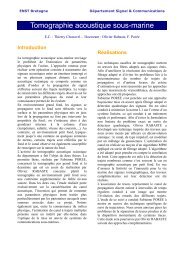Département Réseau, Sécurité et Multimédia Rapport d'Activités 2008
Département Réseau, Sécurité et Multimédia Rapport d'Activités 2008
Département Réseau, Sécurité et Multimédia Rapport d'Activités 2008
Create successful ePaper yourself
Turn your PDF publications into a flip-book with our unique Google optimized e-Paper software.
Managing a Peer-to-Peer Storage System in a Selfish Soci<strong>et</strong>yResearch Staff : Patrick Maillé, Laszlo TokaKeywords : Peer-to-peer, pricing, incentives, game theoryApplications : N<strong>et</strong>work pricing and optimizationPartners & Funding : Institut TELECOM project DisPairSeIntroductionThe possibility of storing data online appearsas a value-adding service in the context of thesoaring “soci<strong>et</strong>y of information”. Indeed,having access to the Intern<strong>et</strong> becomes moreand more easy, with higher and higheravailable transmission rates in accessn<strong>et</strong>works, which renders transfer timesreasonable, even for large files. Moreover,online storage systems are able to cope withdocument versioning, and to protect data notonly against user device failures but alsoagainst disk failures, through the use of datareplicates stored on different disks.For those reasons, many companies nowpropose a service of online data storage.However, while creating such a storage serviceimplies owning huge memory capacities andaffording the associated energy andwarehouse costs, one can imagine using thesmaller but numerous possible storage spacesof the service users themselves, as is done inpeer-to-peer file sharing systems. In such apeer-to-peer storage system, the participantsare at the same time the providers and theusers of the service. To work properly, a peerto-peerstorage n<strong>et</strong>work needs thatparticipants offer a sufficient part of their diskspace to the system, and remain online oftenenough. However, both of those requirementsimply costs (or at least constraints) forparticipants, who may be reluctant to devotesome of their storage capacity to the systeminstead of using it for their own needs.Note that the economic models developed forpeer-to-peer file sharing systems do not applyto peer-to-peer storage services: in file sharingsystems, the data offered by a peer canbenefit to all other peers; in that sense theresource offered to the system is a publicgood. On the contrary, in a peer-to-peerstorage system the memory space offered by apeer is a private good: it can be shared amongdifferent users but each part is then devotedto only one user. Therefore the economicimplications of those systems are necessarilydifferent.Eliciting participants to contributeWe consider two possible incentive schemes,by suggesting that either each peer's use ofthe service should be limited to hercontribution level (symm<strong>et</strong>ric schemes), or thatstorage space be bought from and sold topeers by a system operator that seeks tomaximize profit.The figure presented next illustrates thequantity C i * that is exchanged by user i withdemand function d i and supply function s i inthe case of a symm<strong>et</strong>ric scheme, and thequantity of storing capacity C i o (resp. C i s ) thathe offers (resp. buys) if an operator buys fromand sells storing capacity to participants withunit price p o (resp. p s ).RealizationIn this work, we consider that users behaveselfishly, i.e. are only sensitive to the quality ofservice they experience, regardless of theeffects of their actions on the other users. Theframework of noncooperative Game Theory [1]is therefore particularly well-suited to study theinteractions among peers.We therefore focus on the incentives that canbe introduced to make participants contribut<strong>et</strong>o the system, i.e. the changes that can bebrought to the game to modify its outcomes.Which scheme to prefer?The main question addressed in this work iswh<strong>et</strong>her it is socially b<strong>et</strong>ter to impose asymm<strong>et</strong>ric scheme or to l<strong>et</strong> a profit-maximizing60 Pracom’s Annual Report <strong>2008</strong>















